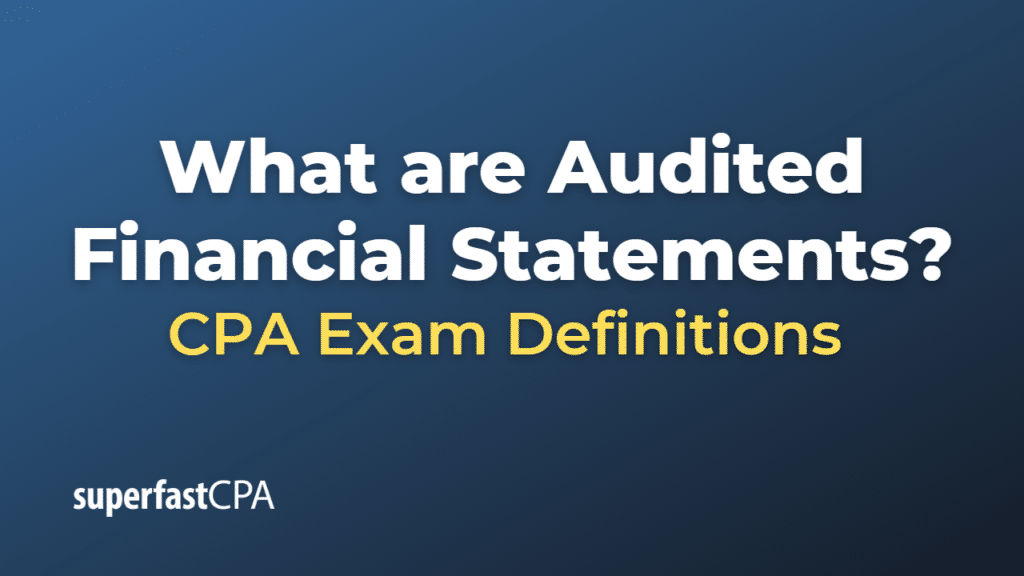Audited Financial Statements
Audited financial statements are a set of financial reports that have been examined and verified by an independent external auditor to ensure their accuracy, completeness, and compliance with the applicable accounting standards and regulations. The primary objective of an audit is to provide a high level of assurance to the users of the financial statements that the information presented is free from material misstatements, whether due to error or fraud.
The typical components of audited financial statements include:
- Balance Sheet: Also known as the statement of financial position, it provides a snapshot of a company’s assets, liabilities, and equity at a specific point in time.
- Income Statement: Also known as the statement of profit and loss, it shows the company’s revenues, expenses, and net income (or loss) over a period, usually a fiscal year.
- Statement of Cash Flows: This statement presents the company’s cash inflows and outflows from operating, investing, and financing activities during a specific period.
- Statement of Changes in Equity: This statement shows the changes in the company’s equity components, such as retained earnings and other reserves, during a specific period.
In addition to these primary financial statements, the audited financial report usually includes:
- Notes to the financial statements: These provide additional information and explanations about the figures presented in the financial statements, including significant accounting policies, estimates, and judgments.
- Auditor’s Report: This is a formal opinion issued by the external auditor, stating whether the financial statements are presented fairly, in all material respects, and in accordance with the applicable financial reporting framework.
Audited financial statements are important for various stakeholders, such as shareholders, investors, lenders, regulators, and the general public, as they rely on these statements to make informed decisions about the financial health and performance of a company.
Example of Audited Financial Statements
Here is a simplified example of audited financial statements for a hypothetical company, ABC Inc., for the fiscal year ended December 31, 202X:
- Balance Sheet (as of December 31, 202X) Assets:
- Cash: $50,000
- Accounts Receivable: $30,000
- Inventory: $40,000
- Property, Plant, and Equipment: $200,000 Total Assets: $320,000
- Accounts Payable: $20,000
- Short-term Debt: $50,000
- Long-term Debt: $100,000 Total Liabilities: $170,000
- Common Stock: $100,000
- Retained Earnings: $50,000 Total Equity: $150,000
- Income Statement (for the year ended December 31, 202X)
- Revenues: $200,000
- Cost of Goods Sold: -$120,000 Gross Profit: $80,000
- Operating Expenses: -$40,000 Operating Income: $40,000
- Interest Expense: -$5,000 Income Before Taxes: $35,000
- Income Taxes: -$10,000 Net Income: $25,000
- Statement of Cash Flows (for the year ended December 31, 202X) Cash Flows from Operating Activities: $35,000 Cash Flows from Investing Activities: -$10,000 Cash Flows from Financing Activities: -$25,000 Net Increase in Cash: $0
- Statement of Changes in Equity (for the year ended December 31, 202X)
- Beginning Retained Earnings: $25,000
- Net Income: $25,000
- Dividends: -$10,000 Ending Retained Earnings: $40,000
These simplified financial statements are accompanied by notes explaining the accounting policies, significant estimates, and judgments made by the company’s management, as well as the auditor’s report stating the opinion on the fairness and compliance of the financial statements with the applicable financial reporting framework.
In this example, the auditor’s report would indicate whether the financial statements of ABC Inc. are presented fairly, in all material respects, and in accordance with the applicable accounting standards.












